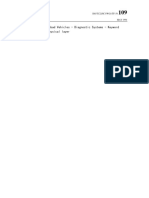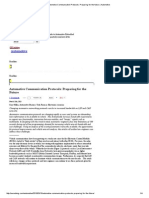KWP 2000
KWP 2000
Uploaded by
vigneshwaranCopyright:
Available Formats
KWP 2000
KWP 2000
Uploaded by
vigneshwaranOriginal Description:
Original Title
Copyright
Available Formats
Share this document
Did you find this document useful?
Is this content inappropriate?
Copyright:
Available Formats
KWP 2000
KWP 2000
Uploaded by
vigneshwaranCopyright:
Available Formats
KWP2000 - Basic Information.
Keyword Protocol 2000, abbreviated KWP2000, is a communications protocol used for on-board
vehicle diagnostics systems (OBD). This protocol covers the application layer in the OSI model of
computer networking.
KWP2000 is a Uart based data link protocol
KWP2000 Message Structure
The message structure consists of three parts
1. Header
2. Data Bytes
3. Checksum
Fmt - Format byte
Tgt - Target Address
Src - Source Address
Len Total length of the telegram
SId - Service Identification byte
CS - Check Sum - 8 bit sum services of all bytes, excluding Checksum
The format byte contains 6 bit length information and 2 bit address mode information. The
client (tester) is informed about use of the header bytes by the key bytes
2 bit address mode information:
Bit 7 Bit 6
0 0 no address information
0 1 Exception mode
-CARB
1 0 physical addressing
1 1 functional addressing
Target address byte : This is the target address for the message and is always used together
with the source address byte.
Source address byte : This is the address of the transmitting device.
Length byte :This byte is provided if the length in the header byte (L0 to L5) is set to 0. It
allows the user to transmit messages with data fields longer than 63 bytes. With shorter
messages it may be omitted.
Data Bytes : The data field may contain up to 63 or up to 255 bytes of information,
depending on the use of length information. The first byte of the data field is the Service
Identification Byte.
Checksum Byte : The checksum byte (CS) inserted at the end of the message block is
defined as the simple 8-bit sum series of all bytes in the message
Physical Addressing : Addressing used to initialize Single server/ECUs.
Functional Addressing : Addressing used to initialize many servers/ECUs
You might also like
- J1979-3 - 202310 - CopieDocument54 pagesJ1979-3 - 202310 - CopieAbderahmen Bouchhima100% (1)
- General Information - Diagnostic Trouble Code (DTC) Indexdtc: Auxiliary Heater Control Module (Ahcm)Document6 pagesGeneral Information - Diagnostic Trouble Code (DTC) Indexdtc: Auxiliary Heater Control Module (Ahcm)Jim LiebNo ratings yet
- LH20100601 CanOpen-Pesa-Elf V101Document31 pagesLH20100601 CanOpen-Pesa-Elf V101Rafał BłaszkiewiczNo ratings yet
- KWP2000 Release2 2Document122 pagesKWP2000 Release2 2Matteo Poggiali100% (1)
- Autosar Srs DiagnosticDocument29 pagesAutosar Srs DiagnosticDaoren MiaozhenNo ratings yet
- CAN Networks Significantly Reduce WiringDocument4 pagesCAN Networks Significantly Reduce Wiringvigneshwaran100% (2)
- Flexray Module Training: Ti Safety MicrocontrollerDocument61 pagesFlexray Module Training: Ti Safety MicrocontrollerGuilherme PfeilstickerNo ratings yet
- ISO WD 14230 1 Road Vehicles DiagnosticDocument11 pagesISO WD 14230 1 Road Vehicles Diagnosticmuhammad.kamalNo ratings yet
- At91sam7 - CanDocument58 pagesAt91sam7 - Cangopismiles1987No ratings yet
- PAM CAN BusDocument44 pagesPAM CAN BusNguyễn Tuấn VũNo ratings yet
- Iso 15031-7-2013Document16 pagesIso 15031-7-2013Sorin SorinNo ratings yet
- NI Tutorial 2732 enDocument5 pagesNI Tutorial 2732 enmanumanu12No ratings yet
- Sae j1978 2002 PDFDocument7 pagesSae j1978 2002 PDFJulio Cesar MartinezNo ratings yet
- 16-2 p30 Mapping of j1939 To Can FD Cia602 ZeltwangerDocument2 pages16-2 p30 Mapping of j1939 To Can FD Cia602 ZeltwangerAlireza RakhshNo ratings yet
- Sae j1962 1995 PDFDocument8 pagesSae j1962 1995 PDFmiguelcastilloNo ratings yet
- To Can Controllers at STDocument11 pagesTo Can Controllers at STRaj Mohan100% (2)
- Can BusDocument19 pagesCan BusVipin JainNo ratings yet
- J1772 Signaling Circuit - SAE J1772 - WikipediaDocument1 pageJ1772 Signaling Circuit - SAE J1772 - WikipediamariusNo ratings yet
- MQB Vag VW Audi Test Platform CableDocument1 pageMQB Vag VW Audi Test Platform CableisacnkunaNo ratings yet
- Arm Instruction SetDocument61 pagesArm Instruction SetswatidasNo ratings yet
- Autosar Sws ComDocument188 pagesAutosar Sws ComMar QuoniNo ratings yet
- KWP2000 Manual PDFDocument20 pagesKWP2000 Manual PDFPljjkjNo ratings yet
- Lauterbach Tricore App OcdsDocument52 pagesLauterbach Tricore App OcdsssssdaNo ratings yet
- Diganostcs For Automobiles-A SnapshotDocument8 pagesDiganostcs For Automobiles-A SnapshotZeljkoSipcicNo ratings yet
- An ION 1 3100 Introduction To J1939Document11 pagesAn ION 1 3100 Introduction To J1939hhNo ratings yet
- Understanding and Using The CAN-1Document41 pagesUnderstanding and Using The CAN-1mail87523No ratings yet
- Arduino EV J1772 Charging StationDocument18 pagesArduino EV J1772 Charging StationakozyNo ratings yet
- Manual - 1.0Document44 pagesManual - 1.0Jimmy AlemanNo ratings yet
- Ixxat Sae j1939Document3 pagesIxxat Sae j1939Dinesh KumarNo ratings yet
- Iso 15031-2Document20 pagesIso 15031-2dongyazhou19891103No ratings yet
- In Vehicle Do IpDocument14 pagesIn Vehicle Do IpKosta1990No ratings yet
- Climate Control in CarsDocument10 pagesClimate Control in CarsSubhan Nur Sobah CHNo ratings yet
- CAN ImplementationDocument24 pagesCAN Implementationshanku kakNo ratings yet
- Iso 15031-4Document40 pagesIso 15031-4dongyazhou19891103100% (1)
- 06 Grundlagen FlexRay v10 enDocument39 pages06 Grundlagen FlexRay v10 envinayNo ratings yet
- Command Server User ManualDocument9 pagesCommand Server User ManualSaddam BasimNo ratings yet
- Iso 14230 2 2016Document15 pagesIso 14230 2 2016YOUNBEOM JHONo ratings yet
- Iso11898 1 2015Document78 pagesIso11898 1 2015liqilovelordjesusNo ratings yet
- Sensor Solutions BR-2016Document56 pagesSensor Solutions BR-2016carlosve87No ratings yet
- CANsuite Operation 1Document8 pagesCANsuite Operation 1afsala1982No ratings yet
- 802.1BA-2011 - IEEE STD For LAN&MANs - Audio Video Bridging (AVB) SystemsDocument45 pages802.1BA-2011 - IEEE STD For LAN&MANs - Audio Video Bridging (AVB) SystemsLenina Viktoriya TeknyetovaNo ratings yet
- Regenerative Braking SystemDocument8 pagesRegenerative Braking Systemsanjay sureshNo ratings yet
- HC 06 DatasheetDocument14 pagesHC 06 DatasheetTiến NguyễnNo ratings yet
- Controller Area Network - IntroDocument28 pagesController Area Network - Intronav_ite100% (1)
- Final Project Presentation 0Document42 pagesFinal Project Presentation 0V Mahesh KumarNo ratings yet
- Standard Chrysler - FGA Controls ArchitectureDocument25 pagesStandard Chrysler - FGA Controls ArchitectureJean RaminhoNo ratings yet
- CAN ProtocolDocument9 pagesCAN Protocolhaythem.mejri.proNo ratings yet
- Can MCP2551Document2 pagesCan MCP2551Bhaskar Rao PNo ratings yet
- Volkswagen-Maintenance Case Circuit Data Book - 01 Trang 81-118Document38 pagesVolkswagen-Maintenance Case Circuit Data Book - 01 Trang 81-118Vinh Dau Nguyen VanNo ratings yet
- Eggine Electronics Management System From ARAIDocument2 pagesEggine Electronics Management System From ARAIdhinesh66No ratings yet
- ECU Look Up TableDocument6 pagesECU Look Up TableAchintya MehrotraNo ratings yet
- Basics of UART CommunicationDocument24 pagesBasics of UART CommunicationKalimuthu PsNo ratings yet
- Fast and Effective Embedded System DesignDocument3 pagesFast and Effective Embedded System DesignAimagin100% (2)
- Testing The Throttle Position SensorDocument4 pagesTesting The Throttle Position SensorkukumarcicNo ratings yet
- Motec M4 - M48 - M8 - Manual - A5Document63 pagesMotec M4 - M48 - M8 - Manual - A5Melissa TanNo ratings yet
- Automotive Communication Protocols - Preparing For The Future - AutomotiveDocument4 pagesAutomotive Communication Protocols - Preparing For The Future - Automotivegrigore_george77No ratings yet
- Crankshaft Position Sensor Inductive, Referenced, Voltage During CrankingDocument7 pagesCrankshaft Position Sensor Inductive, Referenced, Voltage During Crankingdanieldario33No ratings yet
- PLC and HMI Development with Siemens TIA Portal: Develop PLC and HMI programs using standard methods and structured approaches with TIA Portal V17From EverandPLC and HMI Development with Siemens TIA Portal: Develop PLC and HMI programs using standard methods and structured approaches with TIA Portal V17No ratings yet
- 160 TNPSC Indiaya Theesiya Iyakkam 1Document50 pages160 TNPSC Indiaya Theesiya Iyakkam 1jananisp86No ratings yet
- Serial Peripheral Interface: Active LowDocument3 pagesSerial Peripheral Interface: Active Lowvigneshwaran100% (1)
- I2C ProtocolDocument5 pagesI2C Protocolvigneshwaran100% (1)
- Objectives of FlexrayDocument3 pagesObjectives of FlexrayvigneshwaranNo ratings yet
- Comparison of Communication ProtocolDocument2 pagesComparison of Communication Protocolvigneshwaran100% (2)
- Charging SystemDocument15 pagesCharging SystemvigneshwaranNo ratings yet
- Environmental Legislation: Pollution Norms Euro / Bharat StandardsDocument10 pagesEnvironmental Legislation: Pollution Norms Euro / Bharat StandardsvigneshwaranNo ratings yet


































































